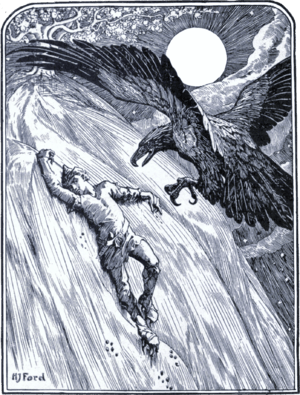The Glass Mountain (fairy tale) facts for kids
Quick facts for kids The Glass Mountain |
|
|---|---|

The eagle attacks the youth on the slopes of Glass Mountain. Illustration from The Yellow Fairy Book (1894).
|
|
| Folk tale | |
| Name | The Glass Mountain |
| Data | |
| Aarne-Thompson grouping | ATU 530 (The Princess on the Glass Hill) |
| Country | Poland |
| Published in | Klechdy (Tome II) by Kazimierz Władysław Wójcicki (1837) |
| Related | The Princess on the Glass Hill |
The Glass Mountain is a classic fairy tale from Poland. Its original name in Polish is Szklanna Góra. This story was later translated into German as Der Glasberg.
The famous writer Andrew Lang helped share this tale with more people. He included an English version in his book, The Yellow Fairy Book. The name "Glass Mountain" also appears in other stories. For example, it's a magical place in Old Rinkrank, a tale from the Brothers Grimm.
Fairy tales are often grouped by their themes. "The Glass Mountain" is known as Aarne–Thompson type 530. This type is often called "The Princess on the Glass Hill" because many stories in this group share similar ideas.
Contents
The Story of the Glass Mountain
The Polish version of "The Glass Mountain" begins with a special place. There was a tall mountain made entirely of glass. On top of this shiny mountain grew a tree. This tree had amazing golden apples.
The Golden Castle and the Princess
Picking one of these golden apples was very important. It was the only way to enter a secret golden castle. Inside this castle lived an enchanted princess. Many brave knights had tried to reach her. But the glass mountain was too slippery. Sadly, many knights failed and lost their lives trying to climb it. Their bodies lay around the base of the mountain.
The Golden Knight's Attempt
One day, a knight wearing shining golden armor decided to try. He was very determined. On his first attempt, he managed to climb halfway up the glass mountain. Then, he calmly went back down. He was preparing for his next try.
The next day, the golden knight tried again. He wanted to reach the very top. He was climbing steadily and doing well. But suddenly, a large eagle attacked him. The eagle was fierce and powerful. The knight and his horse both fell from the mountain. They did not survive the fall.
The Schoolboy's Clever Climb
Later, a clever schoolboy came along. He found a lynx and managed to kill it. He then used its sharp claws. He attached the lynx claws to his own feet and hands. This helped him grip the slippery glass.
The boy started to climb the mountain. It was a very hard climb. He got tired and decided to rest on the slope. The eagle, which had attacked the knight, saw him. The eagle thought the boy was dead. It flew down, planning to eat him.
But the boy was not dead. He quickly grabbed the eagle! The eagle tried to shake him off. As it struggled, it flew higher and higher. It carried the boy the rest of the way up the mountain.
Reaching the Top and a Happy Ending
When they reached the top, the boy cut off the eagle's feet. He then fell into the golden apple tree. The fall caused him some injuries. But the peels of the golden apples had magic healing powers. They cured his wounds.
The boy picked more golden apples. These apples allowed him to enter the golden castle. Inside, he met the enchanted princess. They fell in love and got married.
Bringing Life Back
There was another amazing part of the story. The blood from the eagle had special powers. It brought back to life everyone who had died trying to climb the mountain. This meant all the knights who had failed were now alive again.
Origins of the Tale
Experts have studied the story of "The Glass Mountain." They try to understand where it came from. One idea is that this fairy tale might be very old.
Ancient Connections
Some scholars, like John Th. Honti, think it might be linked to an ancient Egyptian story. This story is called "The Tale of the Predestined Prince." This Egyptian tale dates back to the 11th century BCE. Other experts believe the story might have come from India. This shows how fairy tales can travel and change over many years and across different cultures.

